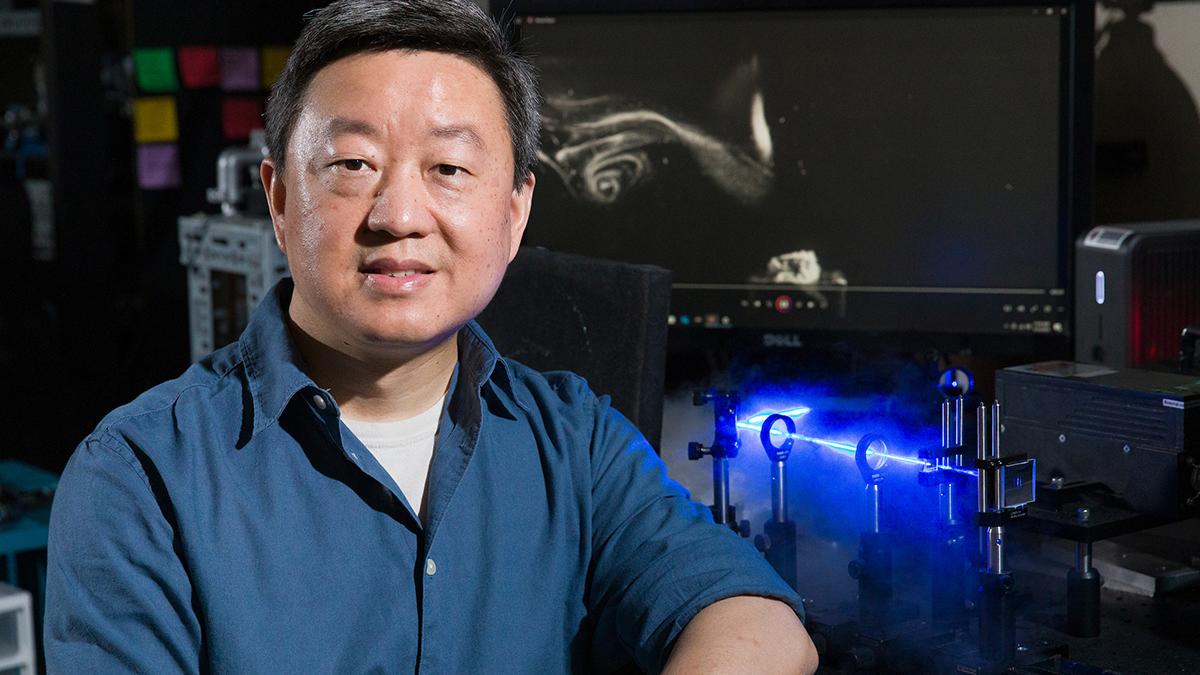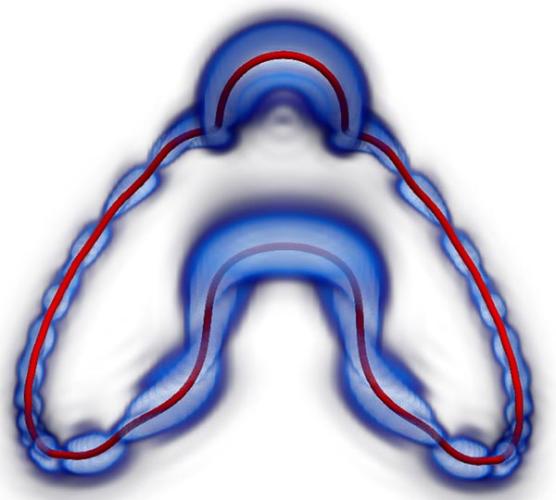
Wei Guo, Ph.D. poses with a laser beam directed into a liquid helium cryostat in the National High Magnetic Field Laboratory in Tallahassee, Florida on May 13, 2025. Guo and his team use the liquid helium cryostat to inject tiny frozen deuterium particles. These particles get trapped on invisible quantum whirlpools—called quantized vortices—in superfluid helium. The laser beam allows the researchers to “see” these particles and track the motion of the vortices to explore the hidden world of quantum fluid dynamics. (Scott Holstein/FAMU-FSU College of Engineering)
A groundbreaking international research collaboration—anchored by scientists from the FAMU-FSU College of Engineering and the National High Magnetic Field Laboratory—has discovered a fundamental universal principle that governs how microscopic quantum whirlpools interact, collide, and transform within exotic superfluids.
Published in the prestigious Proceedings of the National Academy of Sciences (PNAS), this transformative study reveals unprecedented insights into quantized vortex dynamics within superfluid helium—a remarkable liquid that exhibits zero-resistance flow at temperatures approaching absolute zero. The research demonstrates that when these quantum vortices intersect and reconnect, they consistently separate faster than their initial approach velocity, creating irreversible energy bursts that fundamentally characterize quantum turbulence across diverse fluid systems.
Microscopic Quantum Tornadoes
Superfluid helium represents one of nature’s most extraordinary states of matter. When cooled to near absolute zero temperatures, this unique substance transcends conventional fluid behavior—flowing without friction, defying gravity by climbing container walls and penetrating microscopic barriers with ease. Unlike ordinary liquids that can swirl freely, superfluid helium confines all rotational motion to quantized vortices—ultra-thin, hollow tubes that maintain precisely fixed circulation amounts dictated by quantum mechanical principles.
“These vortices are like microscopic tornadoes,” explains Wei Guo, professor of mechanical engineering at Florida State University and the FAMU-FSU College of Engineering, who is the study’s principal investigator. “Each one carries an exact amount of circulation, dictated by quantum mechanics. They are topologically protected, meaning they’re remarkably stable and much easier to track than vortices in regular fluids.”
This exceptional stability transforms these quantum structures into powerful investigative tools for exploring turbulence—one of physics’ most complex and chaotic phenomena that influences everything from aircraft aerodynamics to oceanic current patterns.
Guo’s video below (and here) shows representative reconnection events of quantized vortex lines in superfluid helium. His paper primarily reports that these vortices approach each other much more slowly before reconnection than they separate afterward. This observed time asymmetry arises from energy dissipation during the reconnection process, he explained.
Breakthrough Discovery in Vortex Dynamics
Through sophisticated international collaboration, the research team captured high-resolution imaging and computational simulations revealing the fundamental behavioral patterns of colliding quantum vortices. Their findings establish a universal physical law governing vortex interactions across multiple fluid types and temperature ranges.
“We injected tiny frozen deuterium particles into superfluid helium to make invisible quantum vortices visible, then used a laser sheet and a high-speed camera to capture how these vortices moved and reconnected,” Guo detailed. “The experiments were carried out in a cryostat at the National High Magnetic Field Laboratory, where we could carefully control and observe these ultra-cold fluid dynamics.”

The research team’s breakthrough discovery centers on the time-asymmetric nature of vortex reconnection processes. “We found that after they reconnect, the vortices always move apart faster than they came together,” says Professor Guo. “This time-asymmetry, or irreversibility, turns out to be a fundamental property of how energy moves in fluids—whether they’re quantum or classical.”
Each reconnection event generates sudden energy bursts that propagate throughout the surrounding fluid medium, creating ripple-like effects comparable to cardiac rhythms sending waves through water. When multiple reconnections occur simultaneously within complex vortex networks, these coordinated energy releases can trigger distinctive forms of quantum turbulence with unique characteristics not observed in classical fluid systems.
Engineering and Technology Implications
While quantum vortices exist exclusively in exotic materials like superfluid helium and Bose-Einstein condensates, their behavioral patterns mirror fundamental principles governing vortices in everyday fluids including air and water. This remarkable similarity enables quantum superfluid research to provide unprecedented insights into classical turbulence mechanisms.
“By studying these well-behaved and easily observable quantum vortices, we gain valuable insight into the fundamental nature of turbulence,” explains Yiming Xing, a postdoctoral researcher in Professor Guo’s group. “This understanding could one day help us design more efficient engines, optimize energy transfer in quantum systems, or even improve weather prediction models.”
The research implications extend far beyond theoretical physics, potentially revolutionizing multiple technological domains. Advanced turbulence understanding could enable breakthrough developments in aerospace engineering, renewable energy systems, quantum computing applications, and computational fluid dynamics. Additionally, these findings may contribute to enhanced climate modeling capabilities and more sophisticated atmospheric prediction systems.

International Research Partnership
This transformative research exemplifies the power of international scientific collaboration, bringing together distinguished institutions including Newcastle University (UK), Université Côte d’Azur (France), the IAC-CNR (Italy), and Lancaster University (UK), alongside the comprehensive research teams at FAMU-FSU.
The FAMU-FSU College of Engineering research team includes Yiming Xing (postdoctoral researcher), Yousef Alihosseini (doctoral student) and Professor Wei Guo, demonstrating the institution’s commitment to cultivating next-generation scientific leaders within cutting-edge research environments.
Research Funding and Support
This groundbreaking work has received substantial support from The Gordon and Betty Moore Foundation, the U.S. Department of Energy, and the National High Magnetic Field Laboratory, which operates through National Science Foundation Cooperative Agreement funding and State of Florida investment. These strategic partnerships underscore the critical importance of sustained research investment in advancing fundamental scientific understanding.
The comprehensive funding framework enables sustained investigation into quantum fluid phenomena while supporting advanced experimental facilities and world-class research infrastructure essential for breakthrough discoveries.
Bridging Quantum and Classical Physics
This research transforms seemingly esoteric quantum fluid investigations into powerful windows for understanding one of nature’s most perplexing behaviors. The study establishes quantum superfluids as uniquely valuable platforms for turbulence research, offering clarity and precision impossible to achieve with classical fluid systems.
“Superfluids offer a uniquely clear perspective on turbulence,” Professor Guo reflects. “We’re beginning to understand the universal physics that connect quantum and classical worlds—and that’s an exciting frontier for both science and technology.”
As research teams worldwide continue exploring quantum turbulence mechanisms, these findings provide foundational knowledge for developing next-generation technologies that harness fundamental physics principles for practical applications. The intersection of quantum mechanics and fluid dynamics promises continued breakthroughs with transformative potential across multiple scientific and engineering disciplines.
This pioneering research reinforces the FAMU-FSU College of Engineering’s position at the forefront of quantum physics research while demonstrating the institution’s commitment to international collaboration and scientific excellence that addresses fundamental questions with far-reaching technological implications.
Editor’s Note: This article was edited with a custom prompt for Claude 3.7 Sonnet, an AI assistant created by Anthropic. The AI optimized the article for SEO discoverability, improved clarity, structure and readability while preserving the original reporting and factual content. All information and viewpoints remain those of the author and publication. This disclosure is part of our commitment to transparency in our editorial process. Last edited: 06/04/2025.
RELATED ARTICLES
Two Researchers Each Awarded $5M National Science Foundation Grant for Quantum Science Research
Building a Better Quantum Bit: New Qubit Breakthrough Could Transform Quantum Computing
New Path to Quantum Computing: Research Advances Trapped Electron Quantum Bits
